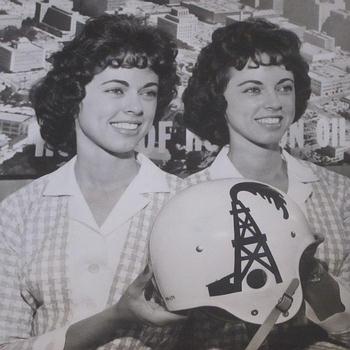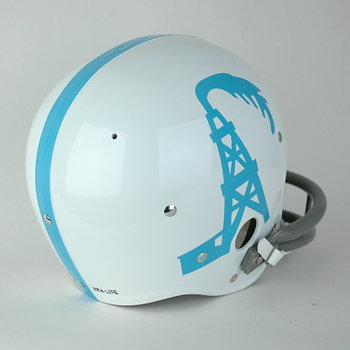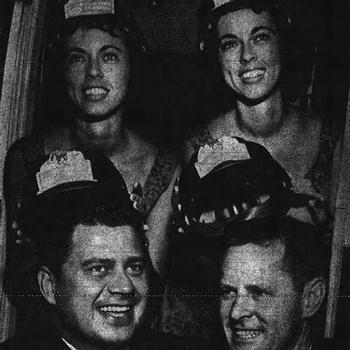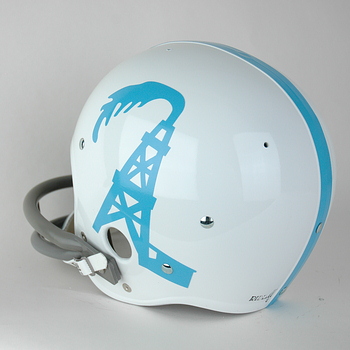

Houston Oilers
1960 Prototype
(Authentic Reproduction)
|
|
 |
When the American Football League first announced its formation in 1959 I was relatively new to my teenage years but more aware and astute of the details of collegiate and professional football than most adults. Having a friend with the same compulsive focus certainly proved to be consistent reinforcement for searching out obscure information and statistics about individual players and teams. Richard Landsman and I could usually bury most adults in the nuts and bolts details of our favorite teams and players. The American Football League was an exciting and interesting new challenge with rosters to memorize and the realization that we would have more “stuff” to learn and know, players to watch and cheer for, and a lot more football to read about and hopefully watch on television. Needless to add, our fascination with uniforms and especially team helmets would be further fulfilled.
|
|
 |
Newspaper photo of Oilers first public game appearance, a hard-fought game
condition scrimmage in Baytown, Texas
Any serious football fan recalls the details relative to the formation of the AFL: the inability of Kenneth “Bud” Adams and Lamar Hunt to purchase an existing National Football League franchise; the refusal of the NFL under the very powerful influence of Chicago Bears founder, owner, and head coach George Halas to consider granting an expansion franchise to both or either of them; the formation of the AFL and “The Foolish Club” designation bestowed upon the newly formed league owners; the battle for public recognition and finally, attracting fan allegiance as the start-up league set itself for a September 1960 kickoff date. Like most of the AFL clubs the Oilers struggled to sign the majority of their top draft choices against the long-established NFL but they did better than most of their AFL brethren. Their ability to sign Heisman Trophy winner Billy Cannon granted the league instant credibility in the eyes of many and the legal wrangling that surrounded the Cannon case firmly established the long-lasting enmity that marked the relationship between the AFL and NFL. Some of the original AFL owners were truly not in a financial position to either battle the NFL nor in some cases, even carry the expenses of their own franchises. Hunt and Adams were on the other side of the spectrum. The famous line uttered by Lamar Hunt’s father, oil magnate H.L. Hunt, often quoted by some utilizing different numbers or doubted by others did accurately reflect the fact that Lamar’s Dallas Texans franchise at least was well funded. When asked if he was concerned that his son’s AFL team had lost one million dollars in its first year of operation, H.L. stated, “Certainly I’m concerned, at this rate Lamar will be broke in 250 years.” Apocryphal or not, both the Texans and Oilers had the resources to outlast most of the NFL franchises.
|
|
 |
Joan and Jane Ryba were the public face of the Oilers when the new AFL team
began a concerted publicity campaign to attract fans throughout Texas and
the surrounding states
With any start-up there are both important issues and those rather mundane that must be addressed and the selection of team colors was done by Oilers owner Bud Adams. His father, Kenneth Stanley “Boots” Adams was another oil industry millionaire many times over after heading the Phillips Petroleum Company. He had been an outstanding high school athlete and played football, basketball, and baseball at the University Of Kansas. Son Kenneth Stanley “Bud” Adams at least briefly followed in his father’s footsteps as a three sport high school athlete who later transferred from Menlo College in California to Kansas and played a year of varsity football for the Jayhawks. He chose the Columbia blue and white that Kansas football teams utilized at the time as their primary colors for the Oilers helmet and jersey, and trimmed the uniform with a bit of red, again similar to Kansas. Adams appointed Rice University basketball coach Don Suman as his first general manager and while this may have stimulated guffaws from old-line NFL types, Houston did win the AFL Championship in both 1960 and ’61 while Suman was in charge. Tough disciplinarian and former Notre Dame and Cleveland Browns star Lou Rymkus was Adams’ first head coach and although many players chafed under his stern leadership model, the Oilers won the inaugural AFL title. In a pattern that would mark the Oilers for some time, Adams fired Rymkus after the October 13, 1961 game against the Boston Patriots, believing that the team’s 1 – 3 – 1 record was far below the predicted expectations of the squad’s talent level. Replaced by Wally Lemm, the Oilers won the remainder of their games and repeated as AFL Champions.
|
|
 |
Long before the opening kickoff on September 11, 1960 that marked the true start of the Houston Oilers as an American Football League team and their march towards that first league championship, a great deal of necessary activity was completed. Rymkus, true to his nature and reputation as one of the toughest linemen to ever play for the legendary Paul Brown at Cleveland, ran a demanding training camp. He had a long list of college seniors whose eligibility had expired, former NFL and CFL players seeking work, a number of long retired high school hotshots who were anxious to trade in their manual labor existence for the opportunity to play professional football, and numbers of others who had the notion that “I could do this!” Like most of the AFL teams, the Oilers evaluation of prospective players reached into triple digits before their opening game. While Rymkus and what proved to be a capable coaching staff prepared the players, Adams and the office staff were busy developing public interest in the upstart league and its Houston entry.
|
|
The AFL Oilers and Texans squared off in their first pre-season game of 1960
What is most obvious about the above photo of the Ryba twins other than their wholesome and attractive appearance is the Oilers helmet that was displayed in a number of public appearances. As one more prop designed to increase awareness and interest in both the new league and the Houston entry, the spouting oil well tower, complete with gushing oil, was an immediate and easy to relate to symbol of the new Oilers team.
The Helmethut staff was intrigued by what may have been a prototype Oilers helmet or perhaps a mere advertising tool. An independent research consultant was called upon to assist in the search for further information with fruitful results. As a fan of the 1960 – late 1970s Oilers, this author was fascinated by some of the information that was uncovered. While Bud Adams had chosen the official Oilers color presumably modeled after his University Of Kansas theme and because it was known to be his favorite, it was expected that an “unadorned” version of the game helmet would be used throughout training camp. Like most professional football teams, the non-decaled and usually unstriped versions were worn during camp and often through the exhibition season to both reduce expenses and the time needed to apply replacement decals and stripes. However the Oilers did maintain a set of white camp helmets and the question arose if these were indeed the “base layer” for what was an earlier version of the Oilers “oil tower decal” helmet that was worn during the exhibition game and regular seasons. Focused investigation of newspaper files extending from Detroit to New Mexico, to New Orleans, to Philadelphia and inclusive of Houston and numerous small towns in the state of Texas provided what proved to be a definitive conclusion. As aforementioned, the inaugural Oilers like most professional teams of that era brought a high volume of potential players into camp. The new American Football League teams especially “turned over every rock” to locate football players that might help build a winning squad. As the Oilers went through this first pre-season camp they sponsored a Blues versus Whites intra-squad game that would be played on July 31, 1960. This was to be the Oilers initial “public playing appearance,” serving the purpose of both reducing the squad to those players deemed worthy of remaining in camp heading into the pre-season game schedule, and to showcase the team to potential fans. While football history notes that the Oilers first exhibition season game was played 540 miles from Houston in Tulsa, Oklahoma near Bartlesville, Bud’s former hometown, the Blues versus Whites intra-squad battle took place in the Houston area enclave of Baytown. The Blues versus Whites game was far more than a scrimmage with men fighting for jobs in a new league. It was truly a hard-fought game of survival. The Blue squad wore what would be the Oilers Columbia blue in-season game helmets with white center stripe and oil tower decals, Columbia blue jerseys, and white pants while the White squad wore white helmets lacking decals. They also displayed rather plain white jerseys with blue numerals and white pants.
Quarterback George Blanda, having jumped from the NFL Bears led the Blues, completing five of eleven passes for 104 yards and a touchdown while Billy Cannon showed the talent that had made him the Heisman Trophy winner in ’59, carrying nine times for seventy-eight yards. Jacky Lee, the University Of Cincinnati’s outstanding quarterback and the first at his position drafted by the AFL also showed well while the underrated Charles Milstead led the White squad. Milstead was often cited as one of the best and toughest players he ever coached by Bear Bryant who tutored Milstead at Texas A&M. TCU Athletic Hall Of Fame member Hugh Pitts who was the LA Rams Rookie Of The Year in 1956 before being felled by a knee injury, led the Blues defense and remained with the Oilers for the 1960 season after the AFL won a court battle for his signing rights from the NFL Dallas Cowboys. Coach Rymkus declared the game a success, noting far fewer mistakes than he expected.
The Oilers went on to win the inaugural 1960 American Football League Championship and repeated the task once again in 1961 before losing to the Dallas Texans in ’62 in what remains as one of the most exciting and memorable games in professional football history. The Columbia blue Oilers uniforms for many fans, remains even more popular and favored than the frequently hyped “powder blues of the San Diego Chargers” that are at times noted as being “the best uniforms ever.” Certainly what appears to be less a prototype Oilers helmet than an advertising and publicity prop would have made for a memorable and excellent official part of the Oilers inaugural uniform. The gushing oil adds life to the original Oilers helmet decal and easily and immediately brings a reminder to the roots of the Oilers beginnings in Houston.
Thanks to Dr. Ken for this article and Bariann for research. You can view Dr. Ken's monthly column from the front page. Just click Helmet News!
|